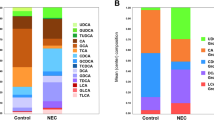Abstract
Serum bile acids and their conjugates were analysed in 20 breast-fed infants with prolonged jaundice. The mean total bile acid levels in serum were increased in the breast-fed infants with jaundice, as compared with those in either breastor bottle-fed infants without jaundice. However, there were no significant differences between the groups. All the breast-fed infants examined, regardless of association with jaundice, had a bile acid pattern dominated by taurine conjugates (the ratio of glycine- to taurine-conjugated bile acid, G/T ratio, less than 1.00). In contrast, the bottle-fed infants without jaundice had a pattern dominated by glycine conjugates (G/T ratio, more than 1.00). Among the breast-fed infants with jaundice, the mean G/T ratio in those who had serum bilirubin levels over 10 mg/100 ml was significantly lower than that in those who had serum bilirubin levels of less than 10 mg/100 ml. The altered bile acid metabolism might be associated with the pathology of breast milk jaundice.
Similar content being viewed by others
Abbreviations
- LP-X:
-
lipoprotein-X
References
Arias IM, Gartner LM, Seifter S, Furman M (1964) Prolonged neonatal unconjugated hyperbilirubinemia associated with breast feeding and a steroid pregnane-3(α),20(β)-diol; in maternal milk that inhibits glucoronide formation in vitro. J Clin Invest 43:2037–2047
Arthur LJ, Bevan BR, Holton JB (1972) Breast milk bilirubin conjugation inhibitors in neonatal hyperbilirubinemia. Arch Dis Child 47:984
Balistreri WF, Heubi JE, Suchy FJ (1983) Immaturity of the enterohepatic circulation in early life: Factors predisposing to “Physiologic” maldigestion and cholestasis. J Pediatr Gastroenterol Nuti 2:346–354
Dorvil NP, Yousef IM, Tuchweber B, Roy CC (1983) Taurine prevents cholestasis induced by lithocholic acid sulfate in guinea pigs. Am J Clin Nutr 37:221–232
Finni K, Similä S, Koivisto M, Hsikura S, Ala-Houhala M (1982) Cholic acid, chenodeoxycholic acid, alpha-fetoprotein and alpha-1-antitrypsin serum concentrations in breast-fed infants with prolonged jaundice. Eur J Pediatr 138:53–55
Foliot A, Ploussard JP, Housset E, Christoforov B, Luzeae R, Odièvre M (1976) Breast milk jaundice: in vitro inhibition of rat liver bilirubin-uridinediphosphate glucuronyltransferase activity and Z protein-bromosulfophthalein binding by human breast milk. Pediatr Res 10:594–698
Hargreaves T, Piper RF (1971) Breast milk jaundice. Effect of inhibitory breast milk and 3α-20β-pregnanediol on glucuronyl transferase. Arch Dis Child 46:195–202
Hashiguchi Y, Kawaguchi M, Nakanishi M, Matsumori Y, Kaneda Y, Nakai C, Mimura K, Matusoka A (1982) Simple, direct measurement of lipoprotein-X in serum. Clin Chem 28:606–608
Kimura H, Suzuki N, Sato T, Goto J, Nambara T (1979) Separatory determination of free and conjugated bile acids in human serum. Jpn J Clin Chem 8:126–130
Muller DPR, Lloyd JK, Wolff OH (1983) Vitamin E and neurological function. Lancet I:225–228
Seidel D, Gretz H, Ruppert C (1973) Significance of the LP-X test in differential diagnosis of jaundice. Clin Chem 19:86–91
Tazawa Y, Konno T (1980) Semiquantitative assay of serum lipoprotein-X in differential diagnosis of neonatal hepatitis and congenital biliary atresia. Tohoku J Exp Med 130:209–217
Thompson JN, Erdody P, Maxwell WB (1973) Simultaneous flurometric determinations of vitamin A and E in human serum and plasma. Biochem Med 9:403–414
Watkins JB, Järvenpää AL, Räihä N, Van-Leeuwen Szczepanik P, Klein PD, Rassin DK, Gaull G (1980) Taurine supplement: Influence on bile acid kinetics. Pediatr Res 14:512
Watkins JB, Järvenpää AL, Räihä N, Van-Leeuwen Szczepanik P, Klein PD, Rassin DK, Gaull G (1982) Human milk changes bile acid kinetics. Pediatr Res 16:181A
Author information
Authors and Affiliations
Rights and permissions
About this article
Cite this article
Tazawa, Y., Yamada, M., Nakagawa, M. et al. Serum bile acids and their conjugates in breast-fed infants with prolonged jaundice. Eur J Pediatr 144, 37–40 (1985). https://doi.org/10.1007/BF00491922
Received:
Accepted:
Issue Date:
DOI: https://doi.org/10.1007/BF00491922




